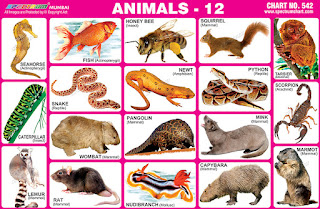Sea Horse (Actinopterygii)
- Seahorse is the name given to 54 species of small marine fishes in
the genus Hippocampus. They are called 'seahorses' because their
head looks like that of a horse. They live in tropical oceans.
Seahorses rely on camouflage to avoid detection. Seahorses range in
size from 1.5 to 35.5 cm.
Caterpillar (Insect) – A
caterpillar is a young butterfly or moth that has just hatched out
of its egg. A caterpillar is a kind of larva. Caterpillars usually
have three pairs of small, but noticeable, true legs at the front
and up to 5 pairs of fleshy false legs at the back. Most
caterpillars are shades of green or brown and are relatively
hairless.
Lemur (Mammal) - Lemur is
type of small primate that can be found only on the island of
Madagascar. Lemur has thin fur that can be black, grey, brown or
reddish coloured. Lemur has pointed nose, huge eyes and long bushy
tail that is much longer than the rest of the body. Lemur eats
fruit, leaves, flowers, tree sap and bark. Plant-based diet is
occasionally supplemented with small vertebrates and insects. Lemur
has lifespan of 18 years in the wild.
Fish (Actinopterygii) -
Fish are vertebrates which live in water and respire with gills.
Fish are found in every ocean, lake, river and stream in all corners
of the globe, in many sizes, colours and species. There are over
33,000 species of fish.
Honey Bee (Insect) - Honey
bee is primarily involved in the production of honey and is today
found worldwide. Honey bee is a herbivorous and therefore lives
purely on the nutrients from plants.
Squirrel (Mammal) -
Squirrels are members of the family Sciuridae, consisting of small
or medium-size rodents. Most squirrels are omnivores, they eat
seeds, berries, pine cones, eat bird's eggs and insects.
Snake (Reptile) - Snakes
are elongated, legless, carnivorous reptiles of the suborder
Serpentes. Snakes are found on every continent except Antarctica.
Most species are non venomous and those that have venom use it
primarily to kill and subdue prey rather than for self-defence. Non
venomous snakes either swallow prey alive or kill by constriction.
Newt (Amphibian) - A newt
is a semi-aquatic amphibian of the family Salamandridae. They can be
found in North America, Europe and Asia. Adult newts have
lizard-like bodies and may be either fully aquatic, living
permanently in the water or semi-aquatic, living terrestrially, but
returning to the water every year to breed.
Python (Reptile) - Pythons
are one of the largest snakes.Pythons don’t attack humans, unless
they are provoked or stressed. They kill their prey by squeezing
them until they stop breathing. Most pythons weigh between 260-300
pounds.
Wombot (Mammal) - Wombat is
an animal that belongs to group of marsupials. It can be found in
southeastern coastal regions of Australia. Wombats prefer wet and
forested areas on the slopes, open grasslands and eucalyptus
forests. Wombat's body is covered with fur that can be ochre, dark
brown or black in colour. Wombats dig underground burrows that can
be 100 feet long. Wombats are herbivores. Their diet consists mainly
of grass, roots, shrubs, moss and bark.
Pangolin (Mammal) -
Pangolin is odd-looking animal that belongs to the group of
anteaters. Pangolin body is covered with hard, brown scales made of
keratin. Scales cover every piece of their body except forehead,
belly and the inner side of their legs. Pangolins have five toes on
each foot. Pangolins are insectivores. Pangolins can eat up to 70
million insects per night.
Mink (Mammal) - Mink is a
mammal that belongs to the family of weasels. Mink is covered with
soft fur that is usually black or dark brown in colour. White marks
can be seen on the chin, throat and chest. Mink is semi-aquatic
animal. Mink is carnivore. Its diet consists of worms, fish,
crayfish, amphibians, birds and small mammals. Mink is nocturnal
creature.
Rat (Mammal) - Brown rat is
one of the best known and most common rats. This rodent has now
spread to all continents except Antarctica. Brown rat is a true
omnivore and will consume almost anything, but cereals form a
substantial part of its diet.
Nudibranch (Mollusc) -
Nudibranchs are a widespread and successful group of marine
Gastropod molluscs. The name means 'naked gills'. They are shelless
and uncoiled Gastropods, famous for their brilliant colours. There
are more than 3000 known species. Most nudibranch are carnivorous.
Capybara (Mammal) -
Capybara live in Central
and South America. They like water and they can be found in swampy
areas, near lakes, ponds, rivers. They have barrel-shaped body
covered with brown wiry fur. They are herbivores. They graze grass
and eat aquatic plants most of the night. They also eat fruit and
bark of the tree. Adult animal eats 8 pounds of grass per day.
Tarsier (Mammal) - Tarsier
is unique type of primate that inhabits southern and eastern parts
of Asia. Tarsiers have a body covered in fur that can be ochre,
brown, gold or grey in colour. Tarsiers have extremely large eyes
and ears and long tail and hind legs. Tarsiers are carnivorous
animals.
Scorpion (Arachnid) -
Scorpion belongs to group called arachnids. There are 1200 species
of scorpions that can be found all over the planet. Scorpions use
pincers to grab its prey. Venom is used both for attack and for
defence. Scorpions are carnivores. They usually feed on insects.
Scorpions do not drink much water and they can survive very long
time without water.
Marmot (Mammal) - Marmots
are large squirrels in the genus Marmota. Marmots typically live in
burrows and hibernate there through the winter. Marmots mainly eat
greens and many types of grasses, berries, lichens, mosses, roots
and flowers.


No comments:
Post a Comment